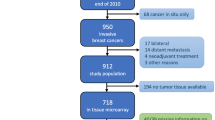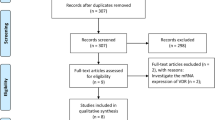Abstract
The expression of vitamin D-receptor (VDR) and retinoid X-receptor α (RXR-α) has been analysed immunohistochemically in benign (n = 62 and n = 5 respectively) and malignant (n = 228 and n = 15 respectively) breast tissue samples using a monoclonal antibody 9A7γ against VDR and a polyclonal antibody against RXR-α. A recently developed immunoreactive scoring method (IRS) was employed. The expression of VDR was detected at the RNA-level using the reverse transcriptase–polymerase chain reaction. A statistically significant higher expression of VDR at the protein level was seen in breast cancer compared with benign breast tissue, whereas at the mRNA level no visible differences in the expression of VDR were found. A higher expression of RXR-α was seen in breast cancer compared with benign breast tissue. Our findings indicate that breast tissue may be a new target organ for therapeutically applied vitamin D and retinoid analogues. VDR and RXR-α are upregulated at the protein level in breast carcinomas as compared to normal breast tissue, indicating a possibly increased sensitivity to therapeutically applied vitamin D analogues. New vitamin D analogues exerting less calcemic side effects may be promising new drugs for the treatment or chemoprevention of breast carcinomas as well as of precancerous breast lesions. Combination therapies of vitamin D and retinoid analogues with fewer side effects seen promising for the treatment of breast cancer.
Similar content being viewed by others
References
Ainsleigh HG (1993) Beneficial effects of sun exposure on cancer mortality. Prev Med 22: 132–140.
Berger U, McClelland RA, Wilson P, Greene GL, Haussler MR, Pike JW, Colston K, Easton D, Coombes RC (1991) Immunocytochemical determination of estrogen receptor, progesterone receptor, and 1,25-dihydroxyvitamin D3 receptor in breast cancer and relationship to prognosis. Cancer Res 51: 239–244.
Brinkmann U, Gallo M, Polymeropoulos MH, Pastan I (1996) The human CAS (cellular apoptosis susceptibility) gene mapping on chromosome 20q13 is amplified in BT474 breast cancer cells and part of aberrant chromosomes in breast and colon cell lines. Genome Res 6(3): 187–194.
Chomczynski P, Sacchi N (1987) Single-step method of RNA isolation by acid guanidinium thiocyanate-phenol-chloroform extraction. Anal Biochem 162: 156–160.
Colston KW, Berger U, Coombes RC (1989) Possible role for vitamin D in controlling breast cancer cell proliferation. Lancet 1(8631): 188–191.
Costa EM, Feldman D (1987) Measurement of 1,25-dihydroxyvitamin D3-receptor turnover by dense amino acid labelling: Changes during receptor upregulation by vitamin D metabolites. Endocrinology 120: 1173–1178.
Curran JE, Vaughan T, lea RA, Weinstein SR, Morrison NA, Griffiths LR (1999) Association of a vitamin D receptor polymorphism with sporadic breast cancer development. Int J Cancer 83(6): 723–726.
Demirpence E, Balaguer P, Trousse F, Nicolsas JC, Pons M, Gagne D (1994) Antiestrogenic effects of all-trans-retinoic acid and 1,25-dihydroxyvitamin D3 in breast cancer cells occur at the estrogen response element level but through different molecular mechanisms. Cancer Res 54: 1458–1464.
Eisman JA, Martin TJ, MacIntyre I, Moseley JM (1979) 1,25-Dihydroxyvitamin D receptor in breast cancer cells. Lancet 2 (8156-8157): 1335–1336.
Eisman JA (1984) 1,25-Dihydroxyvitamin D3 receptor and role of 1,25-(OH)2D3 in human cancer cells. In: Kumar R, ed. Vitamin D Metabolism: Basic and Clinical Aspects. The Hague: Martinus Nijhoff, pp. 365–382.
Fan FS, Yu WC (1995) 1,25-Dihydroxyvitamin D3 suppresses cell growth, DNA synthesis, and phosphorylation of retinoblastoma protein in a breast cancer cell line. Cancer Invest 13: 280–286.
Friedrich M, Reichrath J, Chen TC, Tanpricha V, Gherson I, Tilgen W, Schmidt W, Holick MF (2000) Expression of 25-hydroxyvitamin D3-1α-hydroxylase in breast tissue. In: Norman AW, Bouillon R, Thomasset M, eds. Vitamin D Endocrine System: Structural, Biological, Genetic and Clinical Aspects. Riverside, University of California: Printing and Reprographics, pp. 189–191.
Garland FC, Garland CF, Gorham ED, Young JF (1990) Geographic variation in breast cancer mortality in the United States: A hypothesis involving exposure to solar radiation. Prev Med 19: 614–622.
Gorham ED, Garland FC, Garland CF (1990) Sunlight and breast cancer incidence in the USSR. Int J Epidemiol 19: 820–824.
Haussler MR, Mangelsdorf DJ, Komm BS, Terpening CM, Yamaoka K, Allegretto EA et al. (1988) Molecular biology of the vitamin D hormone. Recent Prog Horm Res 44: 263–305.
Kliewer SA, Umesono K, Mangelsdorf DJ, Evans RM(1995) Retinoid-X receptor interacts with nuclear receptors in retinoic acid, thyroid hormone and vitamin D3 signalling. Nature 355: 446–449.
Krishnan AV, Cramer SD, Bringhurst FR, Feldman D (1995) Regulation of 1,25-dihydroxyvitamin D3 receptors by parathyroid hormone in osteoblastic cells: Role of second messenger pathways. Endocrinology 136(2): 705–712.
Lehmann B, Pietzsch J, Kampf A, Meurer M(1998) Human keratinocyte line HaCat metabolize 1α-hydroxyvitamin D3 and vitamin D3 to 1,25-dihydroxyvitamin D3 (calcitriol). J Dermatol Sci 18: 118–127.
Leid M, Kastner P, Lyons R, Nakshatri H, Saunders M, Zacharewski T et al. (1992) Purification, cloning and RXR identity of the Hela-cell factor with which RAR or TR heterodimerizes to bind target sequences efficiently. Cell 68(2): 377–395.
Lundin AC, Soderkvist P, Eriksson B, Bergman-Jungestrom M, Wingren S (1999) Association of breast cancer progression with a vitamin D receptor polymorphism. South east Sweden breast cancer group. Cancer Res 59(10): 2332–2334.
Majewski S, Skopinska M, Bollag W, Jablonska S (1994) Combination of isoretin and calcitriol for precancerous and cancerous skin lesions. Lancet 344: 1510–1511.
Pike JW, Donaldson CA, Marion SL, Haussler MR (1982) Development of hybridomas secreting monoclonal antibodies to the chicken intestinal 1α,25-dihydroxyvitamin D3 receptor. Proc Natl Acad Sci USA 79: 7719–7723.
Remmele W, Hildebrand U, Hientz HA et al. (1986) Comparative histological, histochemical, immunohistochemical and biochemical studies on estrogen receptors, lectin receptors, and Barr bodies in human breast cancer. Virchows Arch 93: 1292–1297.
Reichrath J, Hügel U, Klaus G, Fusenig NE, Rauterberg EW (1991) Modulation of 1,25-dihydroxyvitamin D3 receptor expression in HaCaT keratinocytes. In: Norman AW, Bouillon R, Thomasset M, eds. Vitamin D: gene regulation, structure function analysis and clinical application. New York, Walter de Gruyter, 445–446.
Rochette-Egly C, Lutz Y, Pfister V, Heyberger S, Scheuer I, Chambon P, Gaub MP (1994) Detection of retinoid X receptors using specific monoclonal and polyclonal antibodies. Biochem Biophys Res Commun 204(2): 525–536.
Rocker D, Ravid A, Libermann UA, Garach-Jehoshua O, Koren R (1994) 1,25-Dihydroxyvitamin D3 potentiates the cytotoxic effects of TNF on human breast cancer cells. Mol Cell Endocrinol 106: 157–162.
Suzuki T, Moriya T, Suguwara A, Ariga N, Takabayashi H, Sasano H (2001) Retinoid receptors in human breast carcinoma: Possible modulators of in situ estrogen metabolism. Breast Cancer Res Treat 65: 31–40.
Tenniswood MP, Guenette S, Lakins J, Mooibroek M, Wong P, Welsh J (1992) Active cell death in hormone dependent tissues. Cancer Metastasis Rev 11: 197–220.
Toma S, Isnardi L, Riccardi L, Bollag W(1998) Induction of apoptosis in MCF-7 breast carcinoma cell line by RAR and RXR selective retinoids. Anticancer Res 18: 935–942.
Veronesi U, De Palo G, Marubini E, Costa A, Fromelli F, Mariani L et al. (1999) Randomized trial of fenretinide to prevent second malignancy in women with early breast cancer. J Natl Cancer Inst 91(21): 1847–1856.
Welsh J, Simboli-Campbell M, Tenniswood M(1994) Induction of apoptotic cell death by 1,25-dihydroxyvitamin D3 in MCF-7 breast cancer cells. In: Norman AW, Bouillon R, Thomasset M, eds. Vitamin D: A Pluripotent Steroid Hormone: Structural Studies, Molecular Endocrinology and Clinical Applications. New York: Walter de Gruyter, 526–527.
Wiese RJ, Uhlnad-Smith A, Ross TK, Prahl JM, DeLuca F (1992) Upregulation of the vitamin D receptor in response to 1,25-dihydroxyvitamin D3 results from ligand induced stabilization. J Biol Chem 267: 20082–20086.
Yu VC, Delsert C, Anderson B, Holloway JM, Devary OV, Naar AM, Kim SY, Boutin JM, Glass CK, Rosenfeld MG (1991) RXR-β: A corregulator that enhances binding of retinoic acid, thyroid hormone and vitamin D3-receptors to their cognate response elements. Cell 67: 1251–1266.
Author information
Authors and Affiliations
Rights and permissions
About this article
Cite this article
Friedrich, M., Axt-Fliedner, R., Villena-Heinsen, C. et al. Analysis of Vitamin D-receptor (VDR) and Retinoid X-receptor α in Breast Cancer. Histochem J 34, 35–40 (2002). https://doi.org/10.1023/A:1021343825552
Issue Date:
DOI: https://doi.org/10.1023/A:1021343825552




